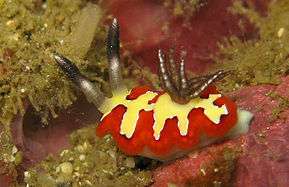Goniobranchus fidelis
| Faithful sea slug | |
|---|---|
 | |
| Scientific classification | |
| Kingdom: | Animalia |
| Phylum: | Mollusca |
| Class: | Gastropoda |
| (unranked): | clade Heterobranchia clade Euthyneura clade Nudipleura clade Nudibranchia |
| Superfamily: | Doridoidea |
| Family: | Chromodorididae |
| Genus: | Goniobranchus |
| Species: | G. fidelis |
| Binomial name | |
| Goniobranchus fidelis (Kelaart, 1858)[1] | |
| Synonyms[2] | |
| |
Goniobranchus fidelis, also commonly known as the faithful sea slug, is a species of colourful sea slug, a dorid nudibranch, a marine gastropod mollusc in the family Chromodorididae.[2][3][4]

Description
The faithful sea slug can reach more than 25 mm length.[5] The body of the animal can be described in two distinct parts: the foot and the mantle. The foot is stretched and almost covered by the edges of the wide mantle, it is cream in colour. The colour pattern of the mantle is marked by a creamy white area with scalloped edges. The whole wide margin of the mantle is orange to red, a burgundy like border, with a variable thickness from one animal to the other, delimiting the two coloured areas.[6] The rhinophores are laminated, contractile and greyish color, whose intensity varies from one animal to another with lighter colour at the tip. Gills have the same colour as the rhinophores but they are retractable.
Distribution and habitat
Distribution of Goniobranchus fidelis include tropical Indo-West Pacific and Red Sea.[5] Its habitat is the external reef area as well on the top or on the slope up to 20 m deep with a preference for dead corals.[7]
Biology
This sea slug is benthic and diurnal, moves without any fear of being taken for a prey, because of the presence of defensive glands distributed in its body tissues and shown to the potential predators through its warning coloration.
References
- ↑ Kelaart, Edward Frederick. 1858. Descriptions of new and little known species of Ceylon nudibranchiate molluscs and zoophytes. Journal of the Royal Asiatic Society Ceylon Branch, Colombo 3(1):76-139, 2 pls. page 97.
- 1 2 Bouchet, P. (2012). Goniobranchus fidelis. Accessed through: World Register of Marine Species on 2012-05-02
- ↑ Rudman W. B. (1985). "The Chromodorididae (Opisthobranchia: Mollusca) of the Indo-West Pacific: Chromodoris aureomarginata, C. verrieri and C. fidelis colour groups". Zoological Journal of the Linnean Society 83: 241-299. doi:10.1111/j.1096-3642.1985.tb00875.x
- ↑ Johnson R.F. & Gosliner T.M. (2012) Traditional taxonomic groupings mask evolutionary history: A molecular phylogeny and new classification of the chromodorid nudibranchs. PLoS ONE 7(4): e33479
- 1 2 Rudman, W.B., 1999 (June 1) Chromodoris fidelis (Kelaart, 1858). [In] Sea Slug Forum. Australian Museum, Sydney.
- ↑ Mitel Cédric, Corolla Jean-Pierre, Warren Lindsay, Leon Virginie, (2015) Goniobranchus fidelis (Kelaart, 1858). in : DORIS, 8/2/2015
- ↑ Bidgrain, P. (2105) Chromodoris fidelis (Kelaart, 1858) South-west Indian Ocean Seaslug site
Further reading
- Rudman W.B. & Darvell B.W. (1990) Opisthobranch molluscs of Hong Kong: Part 1. Goniodorididae, Onchidorididae, Triophidae, Gymnodorididae, Chromodorididae (Nudibranchia). Asian Marine Biology 7: 31-79. page(s): 58
- Debelius, H. & Kuiter, R.H. (2007) Nudibranchs of the world. ConchBooks, Frankfurt, 360 pp. ISBN 978-3-939767-06-0 page(s): 150
- Gosliner, T.M., Behrens, D.W. & Valdés, Á. (2008) Indo-Pacific Nudibranchs and seaslugs. A field guide to the world's most diverse fauna. Sea Challengers Natural History Books, Washington, 426 pp. page(s): 217